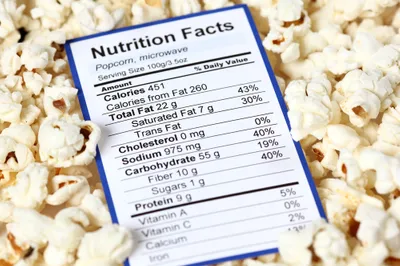When you put together your new bedframe, I bet you read all the instructions before slapping all the pieces together—either that or you had to take it apart mid-assembly and start over again. With any new piece of furniture, form of technology, or mechanical item, you’d do the same, read the instructions first. So why do a large majority of North Americans put food in their bodies without even scanning food labels? It seems logical, right?
From calories to carbohydrates, and from proteins to sodium levels, let’s take some time to properly deconstruct a typical food label and consider the nutritional content of the foods we’re eating…
1. Food Labels: The Big Picture
Considering food labels, or foods you’re about to scarf down, should be approached, firstly, in a broad sense. For example, if you’re watching what you eat or trying to shed a few pounds, your doctor or nutritionist will likely recommend creating a daily meal plan that consists of all the calories, fat, protein, carbohydrates, sodium, vitamins, and nutrients you’ll need for the entire day based on things like your age, weight, activity level, and more.
This is why, when you initially scan any food label, you should do so with consideration of how that food item will fit into your eating for the entire day. This big picture approach to eating will determine what the food offers as far as caloric, carbohydrate, protein, vitamin, and mineral intake for the entire day, and help you decide if it’s a healthy food worth eating.
2. Gauge Serving Size
Typically the top item on your food label is the serving size. This portion is what all of the nutritional information on the entire label will be based upon. Sadly serving size is an item often overlooked by consumers—causing many to mistakenly eat twice or three times the “suggested” portion.
Many of us confuse healthy food choices for poor food choices when we ignore the posted serving size. How many times have you devoured an entire bag of chips or 3 servings of ice cream in one sitting? The truth is that we’re all guilty of neglecting the serving size before digging into a favorite junk food at one time or another. But remember, it doesn’t matter how few calories or how little sodium or saturated fat is in product if the serving size is miniscule.
3. Consider Calories
Most folks blast right past the serving size and right onto the calorie content of any label. It’s not that caloric content isn’t important…it certainly is. Calories represent the energy in the foods we eat, and our daily allowance depends on several factors (i.e., gender, weight, height, and your level of physical activity). However, it’s a common misnomer to assume a food product is healthy because it’s low calorie or “fat free,” which isn’t always the case.
According to nutrition scientists at the University of Chicago, Illinois, our main sources of calories come from protein, fat, and carbohydrate. Ideally, the calories we consume will fill us up and provide adequate energy for the day. However, excess calories taken from fat (which is higher in calories than carbs or proteins), carbohydrates containing sugars (which we tend to eat too much of), and alcohol (which contains more calories per teaspoon than carbohydrates) only sustain you for the short term before you’re tempted to eat again and add more calories to your daily diet.
4. Reflect on Fat Content
I’ve already mentioned that fats are higher in calories than carbohydrates or proteins, which is the main reason why many cut down on fat consumption first and foremost when trying to lose weight. However, it’s wise to remember that not all fats are created equal. When consuming fatty foods, fat type is always more important than fat content.
Research from the Mayo Clinic tells us that healthy dietary fats (i.e., polyunsaturated fats, monounsaturated fats, and omega-3 fatty acids) are essential for energy, sustaining appetite, and for supporting several bodily functions (i.e., heart health and vitamin absorption) when consumed in moderation. However, Trans fats and saturated fats are linked to increasing LDL cholesterol, and increasing weight gain as well as the risk of type 2 diabetes and cardiovascular disease, and should always be consumed in small amounts whenever possible.
5. Ponder Protein
The great thing about North American food labels is that regulations by the U.S. Food and Drug Inspection Agency (FDA) and the Canadian Food Inspection Agency (CFIA) mandate that all ingredients be listed on product packaging in descending order, by weight. This means that you can quickly decipher how rich the food is in protein and what the exact source of protein is—which is vital for those with food allergies or sensitivities, as well as vegetarians, vegans, and those with religious adherences.
Proteins in our food come from either plant (i.e., nuts, tofu, beans, lentils, seeds, and plant-sourced milks) or animal sources (i.e., meat, fish, cheese, yogurt, and animal-sourced milk). This essential macronutrient is necessary for proper growth, body function, and energy. Too little protein in the diet can cause protein deficiency and associated blood clots (or deep vein thrombosis), muscle atrophy, gallstones, sleep deprivation, chronic fatigue, depression, and edema (or swelling) of the belly and legs.
6. Contemplate Carbohydrates
The total carbohydrates listed on any regulated food label should indicate all forms of carbs present in the food product—including carbs from fiber, sugar, and complex carbohydrates. The most important carbohydrate for extremely active individuals and athletes is starch, a complex carb that breaks down into glucose and is stored by the liver and muscles as glycogen. However, the amount of carbohydrates needed in a daily diet vary between individuals according to activity level, age, gender, existing conditions, and blood glucose levels.
The American Diabetes Association (ADA) warns that all carbohydrates affect blood glucose. This is why keeping track of total daily carbohydrates (in grams) is important—particularly for diabetics (with hyperglycemia or high blood sugar) and hypoglycemic (low blood sugar) individuals—so as not to overeat certain carbs (i.e., grains) and ignore others (i.e., fruits and starchy vegetables). The ADA recommends first considering the types of carb you can eat, and then measuring out the portion size to match.
7. Daily Value of Vitamins and Nutrients
Look at any product food label and you will see %DV listed. This refers to the percent daily value (or %DV), which indicates the nutrients and vitamins within any food based on an average 2,000-calorie diet. I agree; it’s a rather inexact science, especially since many of us don’t follow a 2,000-calorie diet.
However, you can still utilize the %DV on food labels to decipher high and low sources of fiber and sodium, as well as certain vitamins and nutrients. However, keep in mind that many foods are fortified with vitamin additives and synthetic nutrients. Whenever possible look to products made with whole or fresh foods that naturally contain vitamins and nutrients and few synthetic additives and salt.
8. Deliberate Dietary Fiber
A simple way to find out if a food product really is a “healthy source of whole grains” is to check the amount of dietary fiber within. As I like to say—the truth is right there on the food label. Despite the hard whole-grain sell in many supermarkets, if a product contains less than 20-percent of the %DV of dietary fiber it’s not an “excellent source of dietary fiber” at all.
Even though fiber is not considered a nutrient, nutritional scientists from the University of Arizona’s College of Agriculture & Life Sciences department say that most North Americans don’t get adequate amounts. Prime sources of dietary fiber include soluble (water-dissolving) and insoluble (non-water dissolving) fibers that come from fruits, vegetables, legumes, and complex carbohydrate grains that are not digested, but excreted from the body.











